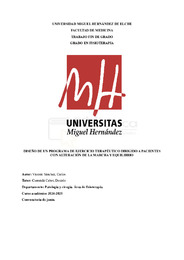Please use this identifier to cite or link to this item:
https://hdl.handle.net/11000/37617Full metadata record
| DC Field | Value | Language |
|---|---|---|
| dc.contributor.advisor | Carratalá Cabot, Desirée | - |
| dc.contributor.author | Vicente Sánchez, Carlos | - |
| dc.contributor.other | Departamentos de la UMH::Patología y Cirugía | es_ES |
| dc.date.accessioned | 2025-10-03T07:28:09Z | - |
| dc.date.available | 2025-10-03T07:28:09Z | - |
| dc.date.created | 2025-05-16 | - |
| dc.identifier.uri | https://hdl.handle.net/11000/37617 | - |
| dc.description.abstract | Introducción; El envejecimiento de la población conlleva una mayor incidencia de alteraciones del equilibrio y la marcha, factores en la perdida de autonomía y en el incremento del riesgo de caídas. Estas caídas representan una de las principales causas de morbimortalidad en personas mayores, siendo un reto prioritario en el ámbito sociosanitario. La fisioterapia basada en el ejercicio terapéutico ha demostrado beneficios sobre el control postural y la funcionalidad, siendo una intervención de alta evidencia científica. Objetivo: Determinar los efectos del ejercicio terapéutico sobre el equilibrio y la marcha en personas mayores. Material y métodos: Diseño de un programa de intervención estructurado y no ejecutado, orientado a personas mayores de 65 años. El programa incluye 3 sesiones semanales durante 12 semanas, divididas en trabajo de fuerza, equilibrio y marcha. Las sesiones incorporan ejercicios individuales, funcionales y en doble tarea, y se adaptan según las capacidades del grupo. | es_ES |
| dc.description.abstract | Introduction: Population aging leads to a higher incidence of balance and gait disorders, which are key factors in the loss of autonomy and increased risk of falls. These falls are among the main causes of morbidity and mortality in older adults, representing a major challenge in the health and social care context. Physiotherapy based on therapeutic exercise has shown benefits in postural control and functional performance, being an intervention supported by strong scientific evidence. Objective: To determine the effects of therapeutic exercise on balance and gait in older adults. Material and Methods: Design of a structured, non-executed intervention program aimed at people over 65 years of age. The program consists of three weekly sessions over a period of 12 weeks, divided into strength, balance, and gait training. The sessions include individual, functional, and dual-task exercises and are adapted to the capacities of the group. | es_ES |
| dc.format | application/pdf | es_ES |
| dc.format.extent | 57 | es_ES |
| dc.language.iso | spa | es_ES |
| dc.publisher | Universidad Miguel Hernández | es_ES |
| dc.rights | info:eu-repo/semantics/openAccess | es_ES |
| dc.rights | Attribution-NonCommercial-NoDerivatives 4.0 Internacional | * |
| dc.rights.uri | http://creativecommons.org/licenses/by-nc-nd/4.0/ | * |
| dc.subject | ejercicio terapéutico | es_ES |
| dc.subject | equilibrio | es_ES |
| dc.subject | marcha | es_ES |
| dc.subject | personas mayores | es_ES |
| dc.subject | prevención de caídas | es_ES |
| dc.subject.other | CDU::6 - Ciencias aplicadas | es_ES |
| dc.title | Diseño de un programa de ejercicio terapéutico dirigido a pacientes con alteración de la marcha y equilibrio | es_ES |
| dc.type | info:eu-repo/semantics/bachelorThesis | es_ES |

View/Open:
UNIVERSIDAD MIGUEL HERNÁNDEZ DE ELCHE - TFG CARLOS.pdf
1,65 MB
Adobe PDF
Share:
.png)
